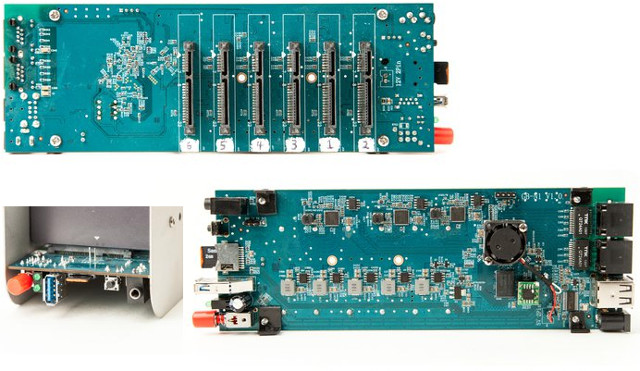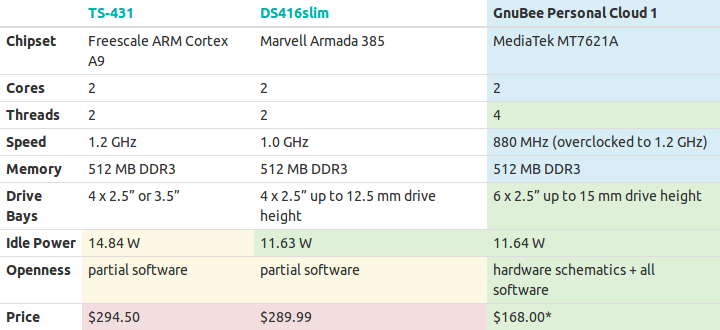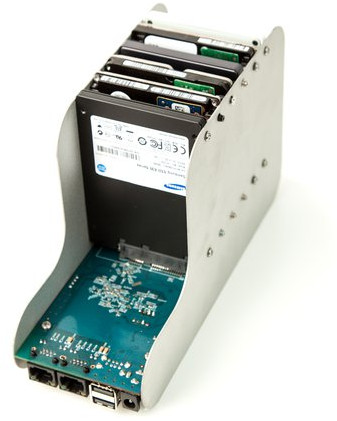Networked Access Storage (NAS) with a large number of SATA bays usually cost several hundreds dollars up to thousands of dollars depending on the features set and performance, but there’s a new a project called GnuBee Personal Cloud 1, or GB-PC1, that delivers a MIPS Linux system supporting up to six 2.5″ SATA drives for less than $200.
- Processor – MediaTek MT7621A dual core, quad thread processor @ 880 MHz, overclockable to 1.2 GHz
- System Memory – 512 MB DDR3
- Storage – micro SD card slot tested up to 64 GB, 6x 2.5” SATA HDD or SSD
- Connectivity – Dual Gigabit Ethernet
- USB – 1x USB 3.0 port, 2x USB 2.0 ports
- Serial port – 3-pin J1 connector or 3.5 mm audio-type jack
- Power – 12 VDC @ 3 A via 5.5 mm x 2.1 mm, center-positive barrel jack
- Dimensions – 21.6 cm (L) x 7 cm (W) x 14 cm (H)
- Weight – ~210 g (without drives)
The case is comprised of two anodized aluminum side plates assembled with six threaded brackets and screws, and comes with 24 drive screws (four per drive).
 The NAS supports Debian, OpenMediaVault, LEDE, as well as the lesser-known (at least to me) LibreCMC distribution. Source code including Linux 4.9 and U-boot, some documentations, as well as the BoM & schematics (PDF) can be found on Github. Potential applications include network storage and backup, file server,home media server, download server, web server, or remotely accessible private cloud.
The NAS supports Debian, OpenMediaVault, LEDE, as well as the lesser-known (at least to me) LibreCMC distribution. Source code including Linux 4.9 and U-boot, some documentations, as well as the BoM & schematics (PDF) can be found on Github. Potential applications include network storage and backup, file server,home media server, download server, web server, or remotely accessible private cloud.
A comparison table has also been provided by the developer with GB-PC1, QNAP TS-431 ($294.22 on Amazon US) and Synology DS416slim ($289.99 on Amazon US).

TS-431 might have an implicit price advantage with support for 3.5″ SATA drives, as you may need less 3.5″ drives to achieve the same amount of storage as with 2.5″ drives. One clear advantage of GB-PC1 is that you should have better control over the software than the two competing commercial solution. One clear disadvantage however is the mechanical design, as GB-PC1 has been designed to offer as low a cost as possible.
GB-PC1 launched on Crowdsupply a few days ago with the goal of raising at least $75,000. Rewards start at $168 for a diskless GB-PC1, but you may also want to add $19 to get a 12V/3A power supply, and potential $6 for a 2 GB micro SD card preloaded with Debian. Shipping is free to the US, and $12 to the rest of the world, with delivery planned for August 2017.
Via Orange Pi’s Facebook Group

Jean-Luc started CNX Software in 2010 as a part-time endeavor, before quitting his job as a software engineering manager, and starting to write daily news, and reviews full time later in 2011.
Support CNX Software! Donate via cryptocurrencies, become a Patron on Patreon, or purchase goods on Amazon or Aliexpress





